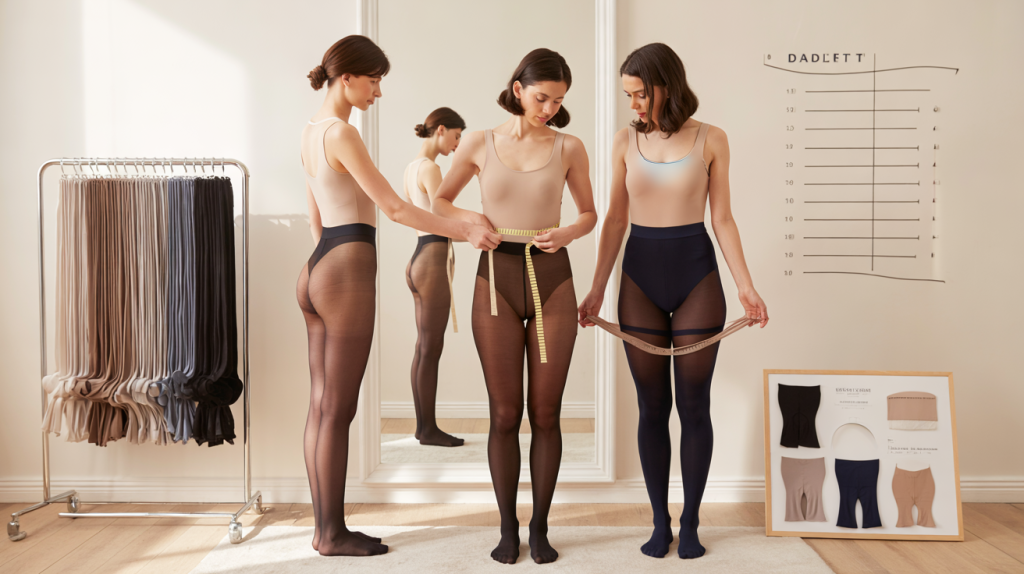Slipping waistbands, digging seams, ladders by lunchtime. Nine times out of ten, it started with the wrong size. The good news is that tights sizing follows a logic you can master fast.
Here is the core of it: brands build size charts from body measurements, usually height with weight or height with hip circumference. The fabric mix and denier then change how that size feels on the leg. Pick with method, not guesswork, and comfort follows.
How women’s tights sizes actually work
Most hosiery charts use a grid. One axis maps height, the other maps weight or hips, then you land on a size code like S-M-L, 1-5, or XS-XL. It looks complex, yet it is simply a way to translate bodies into knit stretch.
International standards sit in the background. ISO 8559-1:2017 defines how to take body measurements for clothing size designation, while EN 13402 uses centimeters for labeling in Europe. These norms keep the measuring consistent, even if each brand sets its own cut and stretch. Sources : ISO 8559-1:2017, EN 13402 overview.
One more variable matters in real life. Denier signals yarn thickness and weight, so a 20 den sheer stretches and behaves differently from an 80 den opaque. Same body, different feel, same chart line.
Measure once: height, hips, and in-between sizes
A tape measure and two quick numbers solve most sizing pain. Height is straightforward. Hips decide the room through the seat and waistband, which is where tights succeed or fail.
Brands are explicit about what to do between sizes. Wolford states: “If your measurements are between sizes, we recommend choosing the larger size.” That single choice reduces snag risk and rolling waistbands. Source : Wolford size guide.
If a label uses weight instead of hips, go with your current weight, not a target number. For curvier hips or longer torsos, look for notes like “extended body,” “curvy,” or “plus.” Many ranges add a gusset or deeper brief to prevent droop.
Calzedonia and similar retailers publish clear grids that map height to weight for each model. Always check the chart tied to the product you buy, not a generic one. Source : Calzedonia size guides.
Quick checklist to lock your size, right now :
- Measure height barefoot against a wall, then hip circumference at the widest point, tape level.
- Open the exact product page and find its chart. Some styles run tighter by design.
- On a border between sizes, pick the larger. It will sit smoother at the waist.
- For control-top or shapewear tights, size up more readily to prevent rolling.
- Maternity styles use trimester-based notes. Follow the brand’s trimester guidance, not a standard grid.
Denier, fabric, and stretch change the fit
Denier is not a size, yet it changes how a size wears. By definition, denier equals grams per 9,000 meters of yarn. So 10 den is ultra-sheer and delicate, 40 den is semi-opaque with firmer hand, 80 den is dense and cozy. Source : Denier definition.
Fiber matters too. Nylon or polyamide provides the body and sheen, while elastane gives recovery. Spandex fibers can elongate roughly 500 to 700 percent at break, which explains why two tights in the same nominal size can feel wildly different based on elastane content and knit structure. Source : Encyclopaedia Britannica, Spandex.
Control-top panels compress more and may feel smaller. Microfibre yarns feel softer and often stretch more evenly along the leg. Footless styles free the toes and can tolerate a bit less length accuracy, while fully fashioned or back-seam pairs demand a closer match to height.
Season plays a role. In winter, thicker opaques reduce sheer risk and add warmth, but they can grip tighter at the knee. In summer, sheers breathe better yet punish a too-small pick with instant laddering. So yes, fabric picks can nudge the size choice.
Brand size charts decoded, from classics to curvy
European labels often list 1 to 5 or 1 to 6, while many US and UK brands use XS to XL with plus extensions like 1X to 4X. The grid logic stays the same, the alphabet just changes. When in doubt, cross-check hips first, then height.
Curvy and tall collections adjust rise and seat depth, not only width. That detail stops the waistband sitting too low. Look for notes like “tall” if you are over 175 cm, or “short” for under 160 cm, as the leg length and panty rise shift.
If sensitive skin is a factor, scan the fabric breakdown and finish. Some brands list OEKO-TEX Standard 100 for product safety. Care labels often suggest 30 °C in a wash bag to preserve elasticity, which helps the size hold up past the third wear.
Final step is boring yet decisive. Try the first pair at home with clean, dry hands, rolling from toe to thigh in stages. If it feels too tight at the brief after a minute of walking, that was the smaller grid cell. The larger one will almost definitly solve it.
